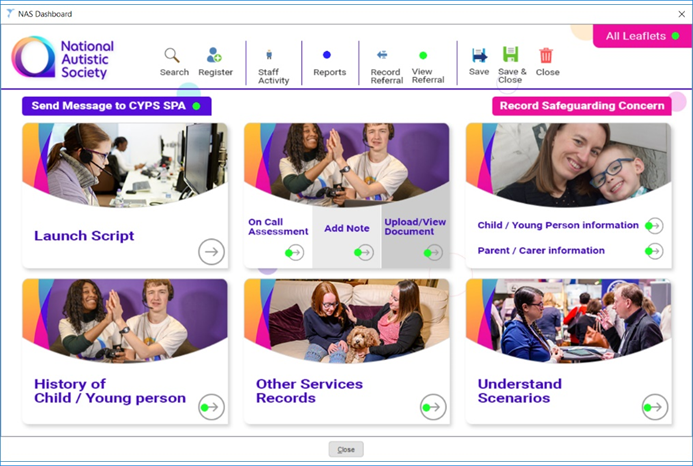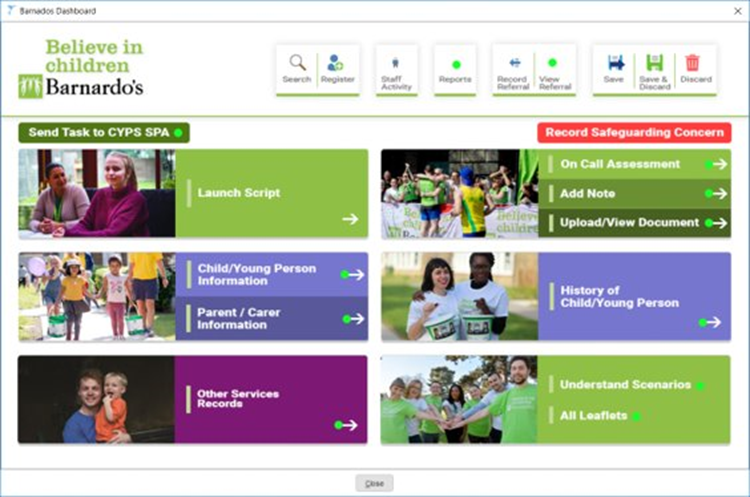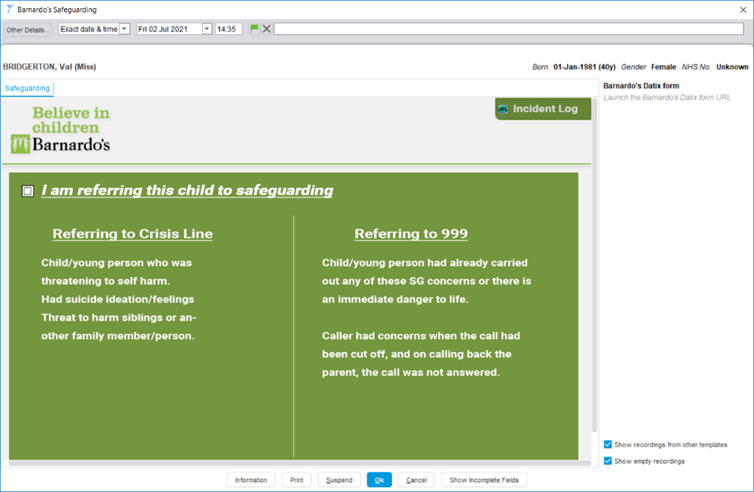Helpline for Parents of Children with Neurodevelopmental Needs
Neurodevelopmental needs: disabilities in the functioning of the brain that affect a child's behaviour, memory or ability to learn e.g. mental health issues, dyslexia, attention deficit hyperactivity disorder (ADHD), learning difficulties and autism spectrum disorder (ASD).
Parenting, although rewarding, is a challenge. What is more challenging though is being the parent of a child with neurodevelopmental (ND) needs. Although the vast majority of parents love their child and wish to do anything to make their lives better and easier, sometimes a parent may not know what to do when their child presents with ND traits.
Two local charities, Barnardo’s and NAS, approached the design team to create a digital solution for their helpline. The helpline for parents and carers of children with ND needs was designed to be a listening ear during difficult times, and provide advice and strategies to cope.
At a glance
-
1. Discovery
Workshops and interviews with users and stakeholders to gather requirements.
Insights analysed and organised into themes to create high-level design implications.
-
2. Design and Testing
High-fidelity prototypes created, internally reviewed and usability tested with users.
Insights gathered such as a need to remove certain functionality and create an interface that was autism-friendly.
-
Development
Insights from usability testing gathered and used to further iterate designs.
Engagement with internal teams to create deisgns that meet organisational needs.
Discovery Phase
The Problem
At the beginning of discovery, I took the time to come to an understanding of the proposed problem. The problem required us to gain answers to various questions:
What does Neurodevelopment support look like? What are the components of this service?
What service streams are being offered by NAS and Barnardo’s?
Are the services offered by Barnardo’s and NAS mutually exclusive or inclusive?
How can Design Team support ND Pathways with digital tools? Which tools?
How do the services offered operate at present?
Based on the initial discussions with NAS and Barnardo’s and desk research, we were able to establish the problem:
“There is a need for a digital solution to help NAS and Barnardo’s manage an out of hours help line for ASD and ADHD cases. This tool should allow for relevant information to be recorded on the child in an efficient and accurate manner which should then be available to SABP clinicians”.
Interviews
NAS
An 60 minute in-depth interview was conducted with the Children’s Services Manager.
Barnardo’s
A group interview session was conducted with the Service Manager, Assistant Director, and Information Management Officer.
Discussion Questions
Due to the simplicity of the ask, I used a ‘job to be done’ approach to gathering requirements for the digital solution.
We discussed the following questions:
What does the support look like?
Does support for parents of children with ADHD differ from that of ASD?
How is the support offered to the CYPF? What tools are used?
What tasks will you need the solution to complete?
Are the users in your organisation comfortable with learning new technologies?
What would success in this project look like to you?
Thematic Analysis
I gathered the needs and insights, synthesising them and ordering them into high-level themes which could be presented to the designers.
-
Helpline Operator
I also created a scenario-based persona from the requirements and needs gathered in the discovery.
I included their goals and needs as well as a typical scenario in their everyday work. This allows the designers to visualise the context in which their solution would be appreciated by the users.

-
Parent
There was not the time or capacity to interview parents in this research phase so I looped in a researcher from another team. He had extensively interviewed parents for a different project relating to ND Needs.
We collaborated on creating a personas for the parents in the helpine context based off of his findings.

To assist in organising the requirements we had received from the users, we coordinated a co-design workshop. With the MOSCOW method we allowed the users to vocalise what was most important for their digital solution.
Barnardo’s
National Autistic Society
Design Phase
The design team set about creating initial prototypes within the Electronic Patient Record.

The Barnardo's Homepage

The Barnardo's On-Call Assessment page allowing users to input essential information

A page to add miscellaneous notes to a patient record

The NAS Homepage

The reports page where users can track calls and capacity

The route a user can take to record a safeguarding incident
Testing
Testing sessions were conducted with the users from NAS and Barnardo’s. The objective of testing is to ensure the solution completes the tasks the user wants to and that the interface makes sense to the user.
Myself and the designers collaborated on creating user scenarios which tested a variety of routes, tasks and features built into the prototype.
We conducted 8 x testing sessions across the two charities and noted down our observations.
The observations were compiled into an improvement log and categorised them between tasks for the configuration of the prototype and for training.
The tests unearthed a few key elements of the design to be adjusted:
NAS
The interface. Making the colours and design more autism-friendly as some of the users had autism.
Removal of on-call assessment as the questions didn’t align with NAS’ advice offered.
Barnardo’s
Free text boxes in the On-Call Assessment screen need to be enlarged so that users can easily see what they have written.
Some functions were not immediately obvious to user from Dashboard screen such as Staff Activity Log, Uploading Documents and CYP History and Data.
Registration took too long and some fields could be made into dropdown options or removed entirely to streamline the process.
Development Phase
It was necessary to engage with internal teams through interviews and workshops to ensure the solution met organisational needs. We conducted two workshops with CAMHS (the children’s mental health service) and with clinical safety teams to ensure the solution was safe for the end user.
The issues and concerns raised were grouped into themes to address within either the solution, the process or in training.
-
Caseload Management
Alerts in patient record to inform CAMHS Clinicians when information is added to record of a child on their scope.
Notes only going to them regarding a child that is relevant to their caseload.
Assisting CAMHS clinician with more information instead of adding more to caseload/waiting list.
-
Data Story/Quality
Proforma detailing quality and standard of data expected from users.
Training users to enter data that is clear and useful to CAMHS.
Reporting on data to assess impact of service.
.
-
Losing contact or connection during call
Losing phone or internet connection could lead to losing contact with a parent in an urgent situation or the user being unable to log details in the digital solution and therefore recording on paper.
The risk was mitigated with the following controls:
Contact details logged immediately as part of the workflow.
Paper kept in locked safes until it can be entered into system/.
-
Safeguarding
The clinical safety team were concerned that safeguarding concerns are raised in a timely and accurate manner.
The safety of the child in question is of paramount importance.
Further Iterations
The key areas for further iteration were:
The lack of autism-friendly design in the NAS solution.
Insufficient digital support for recording and reporting safeguarding concerns.
The on-call assessment.
The question of how information would flow from the charities to CAMHS.

The routes to record a safeguarding concern and sending notes to CAMHS are more prominent

Safeguarding information and guidance added

A process and standard operation procedure created

NAS colours adjusted to be autism friendly and on-call assessment removed
Feedback
“We are so happy with the process and how you have listened to us. The learning curve has been great for us.”
— Barnardo’s Clinical Lead
“Amazing! Love the look and feel, can't wait to see more of this in other services...”
— Colleague




